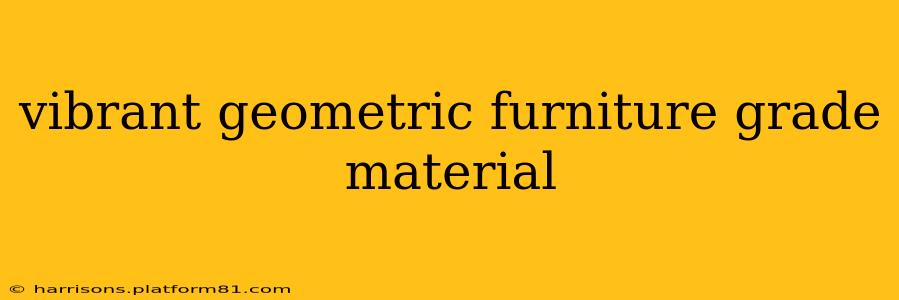Geometric furniture is experiencing a surge in popularity, bringing bold shapes and striking designs into modern homes. But the true magic lies in the materials used to bring these designs to life. Choosing the right material can dramatically impact the overall look, feel, and longevity of your geometric pieces. This guide explores vibrant geometric furniture, focusing on the diverse materials available and how to select the perfect one for your needs.
What are some vibrant geometric furniture grade materials?
The beauty of geometric furniture design lies in its adaptability. A wide range of materials can be used to create these eye-catching pieces, each lending its unique character and aesthetic. Some of the most popular include:
-
Wood: From rich, dark walnut to bright, bleached oak, wood offers a natural warmth and versatility. Different wood species boast distinct grain patterns, adding to the visual appeal of geometric designs. Solid wood is ideal for pieces requiring durability and longevity, while engineered wood provides a more budget-friendly option.
-
Metal: Steel, brass, copper, and aluminum all offer a modern, industrial edge. Metal's strength allows for intricate geometric designs and bold silhouettes. Powder-coated finishes offer a wide range of vibrant colors, further enhancing the geometric aesthetic.
-
Acrylic/Plexiglass: This transparent or translucent material offers a sleek, contemporary look. Its versatility allows for creative layering and the creation of light-diffusing pieces. Acrylic's vibrant color options can be incorporated seamlessly into geometric designs.
-
Laminate: A cost-effective and durable option, laminate offers a vast array of colors, patterns, and textures. It can convincingly mimic the appearance of more expensive materials like wood or stone, making it a practical choice for achieving vibrant geometric designs.
-
Concrete: For a truly industrial and modern look, concrete offers a unique textural element. While not typically considered "vibrant" in the traditional sense, its inherent neutral tones provide a strong base for incorporating vibrant accent colors through paint or other finishes.
What materials are best for outdoor geometric furniture?
Outdoor furniture faces the elements, requiring materials that are weather-resistant and durable. For vibrant geometric outdoor pieces, consider:
-
Powder-coated aluminum: Lightweight yet strong, powder-coated aluminum resists rust and corrosion, and comes in a wide variety of colors.
-
Weather-resistant wicker/rattan: Synthetic wicker or rattan offers a natural look with enhanced durability for outdoor use, though it may not be as durable as metal options over the long term.
-
Teak wood: A naturally weather-resistant hardwood, teak maintains its beauty over time, providing a luxurious and durable option, although it can be more expensive than other choices.
How do I choose the right material for my geometric furniture?
The best material for your geometric furniture depends on several factors:
-
Your style: Do you prefer a modern, industrial look or a more rustic, natural aesthetic? The material you choose will heavily influence the overall style.
-
Your budget: Some materials, such as solid wood or teak, are more expensive than others.
-
Intended use: Is the furniture for indoor or outdoor use? This will impact the necessary durability and weather resistance.
-
Maintenance: Some materials require more maintenance than others. Consider how much time and effort you are willing to dedicate to upkeep.
What are the pros and cons of using different materials for geometric furniture?
This section would require a table format for optimal clarity and readability. Due to the Markdown limitations in creating tables with consistent formatting and styling, I'll provide a textual outline of how this section should be structured. A well-designed table comparing materials based on cost, durability, maintenance, aesthetic, and suitability for indoor/outdoor use would be highly effective here.
Example Table Structure:
| Material | Cost | Durability | Maintenance | Aesthetic | Indoor/Outdoor |
|---|---|---|---|---|---|
| Solid Wood | High | High | Moderate | Natural, Warm | Indoor/Outdoor |
| Engineered Wood | Moderate | Moderate | Low | Varied | Indoor |
| Metal | Moderate | High | Low | Modern, Industrial | Indoor/Outdoor |
| Acrylic | Moderate | Moderate | Low | Sleek, Modern | Indoor |
| Laminate | Low | Moderate | Low | Varied | Indoor |
| Concrete | Moderate | High | Low | Industrial, Modern | Indoor/Outdoor |
This table would be followed by a detailed explanation of the pros and cons for each material, reinforcing the points already discussed in previous sections.
By carefully considering these factors, you can choose the perfect material to bring your vision of vibrant geometric furniture to life. Remember to prioritize quality and durability to ensure your furniture pieces remain a focal point in your home or space for years to come.
